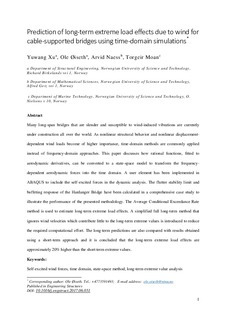Prediction of long-term extreme load effects due to wind for cable-supported bridges using time-domain simulations
Journal article
Submitted version
Permanent lenke
http://hdl.handle.net/11250/2462212Utgivelsesdato
2017Metadata
Vis full innførselSamlinger
- Institutt for konstruksjonsteknikk [2483]
- Institutt for marin teknikk [3472]
- Institutt for matematiske fag [2531]
- Publikasjoner fra CRIStin - NTNU [38688]
Sammendrag
Many long-span bridges that are slender and susceptible to wind-induced vibrations are currently under construction all over the world. As nonlinear structural behavior and nonlinear displacement-dependent wind loads become of higher importance, time-domain methods are commonly applied instead of frequency-domain approaches. This paper discusses how rational functions, fitted to aerodynamic derivatives, can be converted to a state-space model to transform the frequency-dependent aerodynamic forces into the time domain. A user element has been implemented in ABAQUS to include the self-excited forces in the dynamic analysis. The flutter stability limit and buffeting response of the Hardanger Bridge have been calculated in a comprehensive case study to illustrate the performance of the presented methodology. The Average Conditional Exceedance Rate method is used to estimate long-term extreme load effects. A simplified full long-term method that ignores wind velocities which contribute little to the long-term extreme values is introduced to reduce the required computational effort. The long-term predictions are also compared with results obtained using a short-term approach and it is concluded that the long-term extreme load effects are approximately 14% higher than the short-term extreme values.
